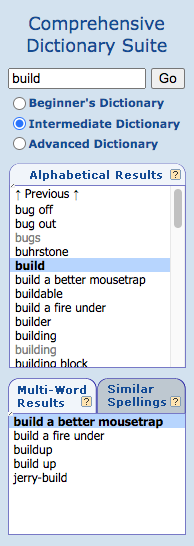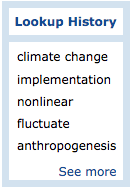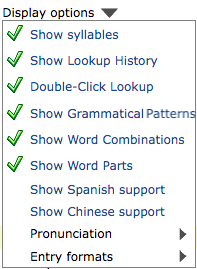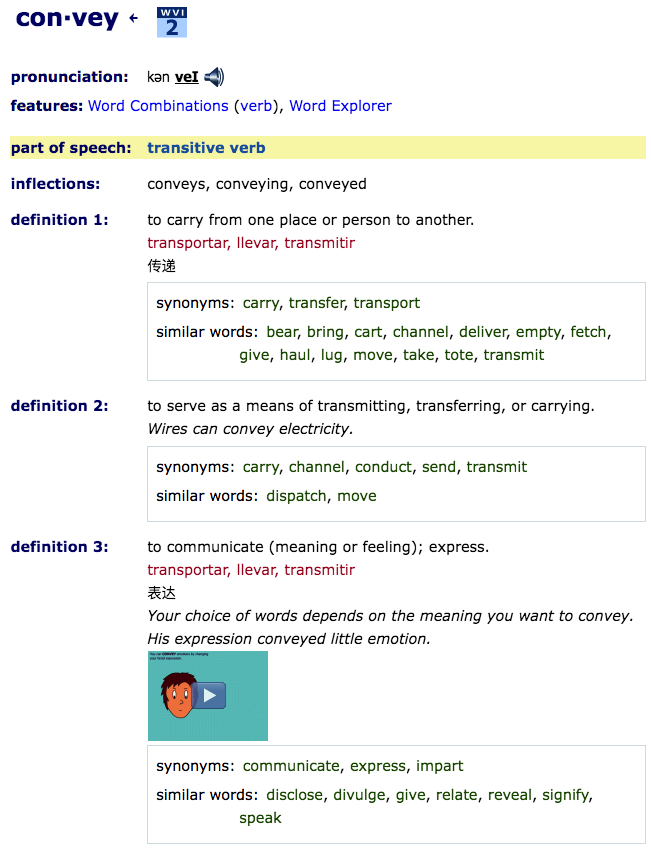
Search Bar
• Look-up box: To look up a word, type it in the search box and click Go or hit Enter on your keyboard.
• Default Selection: Click on the radio button next to the dictionary you want us to check first when searching for a word. This will be your default level. If you want to see entries that contain easy-to-read definitions and the smallest number of definitions for each word, select “Beginner’s Dictionary.” If you want to see entries that contain more advanced language and the greatest number of definitions for each word, select “Advanced Dictionary.” (After you select your default level, you can still navigate between levels if you want to see more or less advanced definitions for a particular word that you’ve looked up. This will not change your default.)
• Alphabetical Results: Here are words and phrases that appear alphabetically before and after your search word. Those in the list that are headwords are in dark gray, and words that are derived or inflected forms of headwords are in light gray. Double click on a word or phrase in the list to go to its entry.
• Multi-Word Results: If there are phrases or compound words that include the word you have looked up, they will appear in Multi-Word Results.
• Similar Spellings: Click on the Similar Spellings tab to see other headwords that are close in spelling to the one you looked up.
Entry display options

• Dictionary menu: This gives you the option to see the entry for the word you looked up in one of our other dictionaries, at a different level of writing.
• More Results: The More Results menu provides three further options for getting information from your search. Multi-Word Results shows phrases and compounds that contain the entry word, along with the first definition for each. Browse in word list shows the word in the middle of the dictionary word list so you can see the words coming before and after it, along with their definitions. The third option, See entries that contain…, shows a list of entries using your looked-up word in their definitions.


• Display Options: Several display features can be controlled in your settings panel. (If you are signed in, you will see the Settings link in the top right corner of the page.) In addition, the Display options menu on the entry page allows you to change existing settings in the entry itself. The options include:
- Show Syllables (displays how words are divided in writing)
- Show Lookup History
- Double-Click Lookup (allows double-clicking on any word in a definition or example sentence to go to that entry)
- Show Grammatical Patterns (reveals the patterns verbs follow as demonstrated in their example sentences and provides links to more information on the patterns)
- Show Word Combinations (shows words that often combine with the word you looked up)
- Show Word Parts (allows the user to see the roots and affixes that make up the headword and gives additional information)
- Show Spanish Support/Show Chinese support (translates headwords and examples sentences for intermediate level words)
- Pronunciation (allows choice of pronunciation systems. Options are Wordsmyth pronunciation system, Phonics, and International Phonetic Alphabet)
- Entry Formats (offers options of “Standard” or “Classic”)
• Lookup History: If you have chosen to display your lookup history on the results page, the last five words you have looked up will be displayed in this box, along with an option to see more looked-up words along with definitions.
Entry

• Headword: Words that have an entry in the dictionary are called entry words or headwords. They always appear at the top of the entry in large blue letters. Dots are used in entry words of more than one syllable to show how the word is divided in writing. The blue arrow next to the syllabified word allows you to turn syllabification on or off.
• WVI label: Words that are part of the Wordsmyth Vocabulary Inventory are marked with a label that shows what level they have been assigned to. Levels range from 1 to 5, with 5 being the most advanced.
• Pronunciation: Headword pronunciation is provided using both written phonemic symbols and human-voiced audio recordings. Clicking on the speaker icon allows you to hear the headword pronounced, and clicking on the word “Pronunciation” provides you with an explanation of the particular pronunciation system being used to display the written symbols—Wordsmyth, Phonics, or IPA. (The pronunciation system shown is the one that has been selected in your display settings.)
• Features: The features list shows the particular special features, such as Word Combinations, Word Explorer, and Word Parts that accompany the word’s entry. Clicking on a feature’s name will lead you down the entry to the feature’s location.

• Part of Speech: The Part of Speech label indicates the way, or one of the ways, that a headword can be used in a sentence—for example, as a noun, transitive verb, intransitive verb, or adjective. In any entry, click on the Part of Speech label (in dark blue) to see an animation explaining what a part of speech is. Click on the name of the part of speech listed next to the label (in light blue) to see an explanation of that particular part of speech.
• Inflections: The inflections field shows the different forms that a headword can take—forms such as “eats,” “eating,” “ate,” and “eaten”—which make up the inflections for the verb “eat.” In any entry, click on the Inflections label (in dark blue) to learn more about what “inflections” are and how Wordsmyth displays them.
• Definitions and Examples: A definition is a short explanation of what a word means. Each word may have several meanings, also called “senses,” depending on how the word is used. The example sentence or phrase below the definition shows a typical usage of the word. Examples consist mostly of full sentences and demonstrate both the meaning and the grammatical context that the word is typically found in. Examples are always in italic type.
• Images and Animations: Thumbnail images are shown beneath the definition and example sentence. Clicking on a thumbnail will enlarge it. Some images are photographs and some are illustrations done by Wordsmyth artists. Illustrations and animations are geared toward children but are still helpful for older learners.
• Synonyms and Antonyms: Synonyms are different words whose meanings are the same or almost the same as each other. Antonyms are words whose meanings are the opposite or nearly the opposite. Synonyms and antonyms are listed with the definitions of a headword with which they match. Click on any synonym or antonym (in green) to see its entry and compare usage.
Derivations: The Derivations field shows words that are derived from the headword, such as “heaviness” from the headword “heavy” and “agreeably” from the headword “agreeable.” Bear in mind that many words that are derived from headwords may not be listed as derivations as they have their own individual entries in the dictionary.
Special features
• Word combinations: The Word Combinations feature displays words that are frequently used in combination with the headword you looked up. The sets of words that are shown in this field can help you find a word that is correct or appropriate to complete a particular meaning that you intend.
• Word Parts: The Word Parts feature shows the headword broken down into its roots and affixes. Each significant word part is identified and its origin, type, and meaning provided. You can also view a list of other example words containing the word part and jump to those words’ dictionary entries to explore further.
• Grammatical Patterns: (in Advanced Dictionary only) The grammatical patterns feature allows you to see what patterns a headword verb follows. Example sentences that demonstrate a pattern are marked with the name of that pattern, and clicking the pattern name will open up a more detailed explanation of the pattern, along with a list of other words that function in the same way and links to our full grammatical patterns list.
• Language Notes: There are four kinds of language notes: Word History, Usage Note, Homophone Note, and Word Builder. These notes appear with a yellow background toward the end of the entry. In some cases, words have more than one language note.
• Word Explorer: Word Explorer is a word finder and vocabulary exploration tool. Several thousand words in the dictionary have Word Explorer information. These entries are linked with a main Word Explorer entry (a “keyword” such as “art,” “weather, or “energy”). The headword “easel,” for example, refers you to the keyword “art.” The Word Explorer keyword entries display related words in categories, e.g., words that describe kinds of art, things used in art (such as an “easel”), people who make art, places for art, etc. Word Explorer is an especially useful tool for children writing on a particular topic, as it sparks ideas for what they may want to say and provides them with needed vocabulary.

